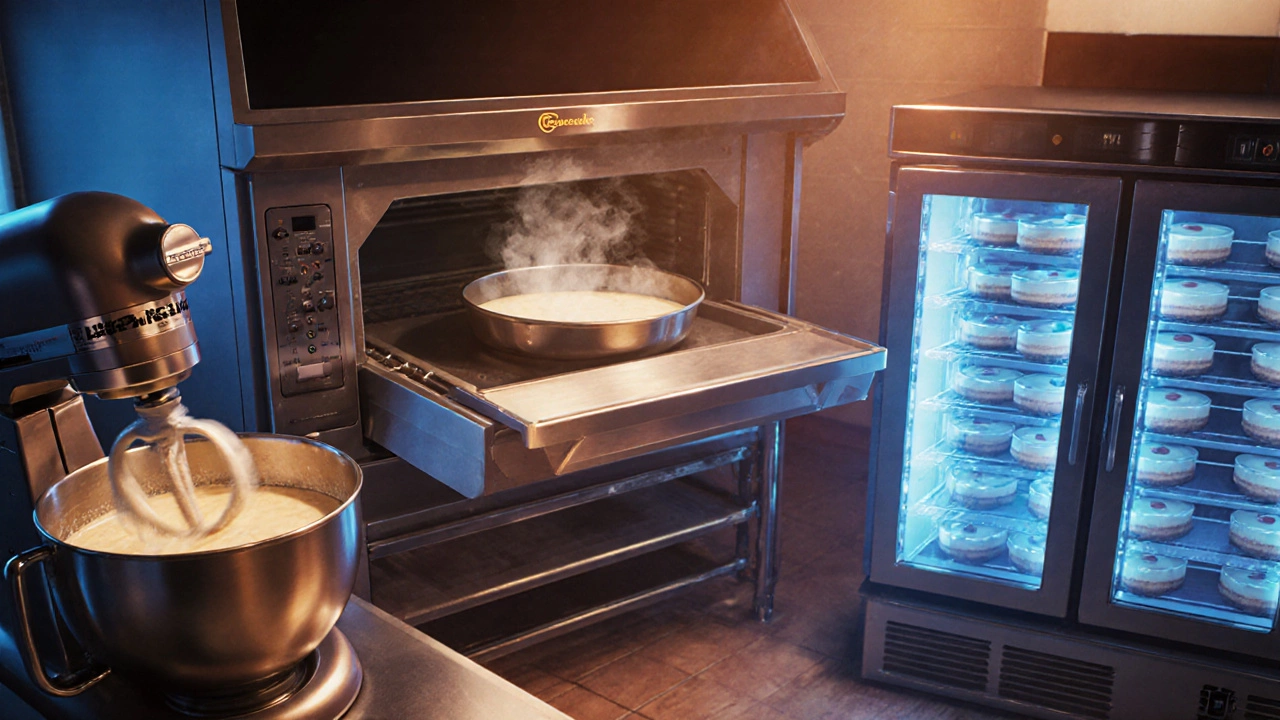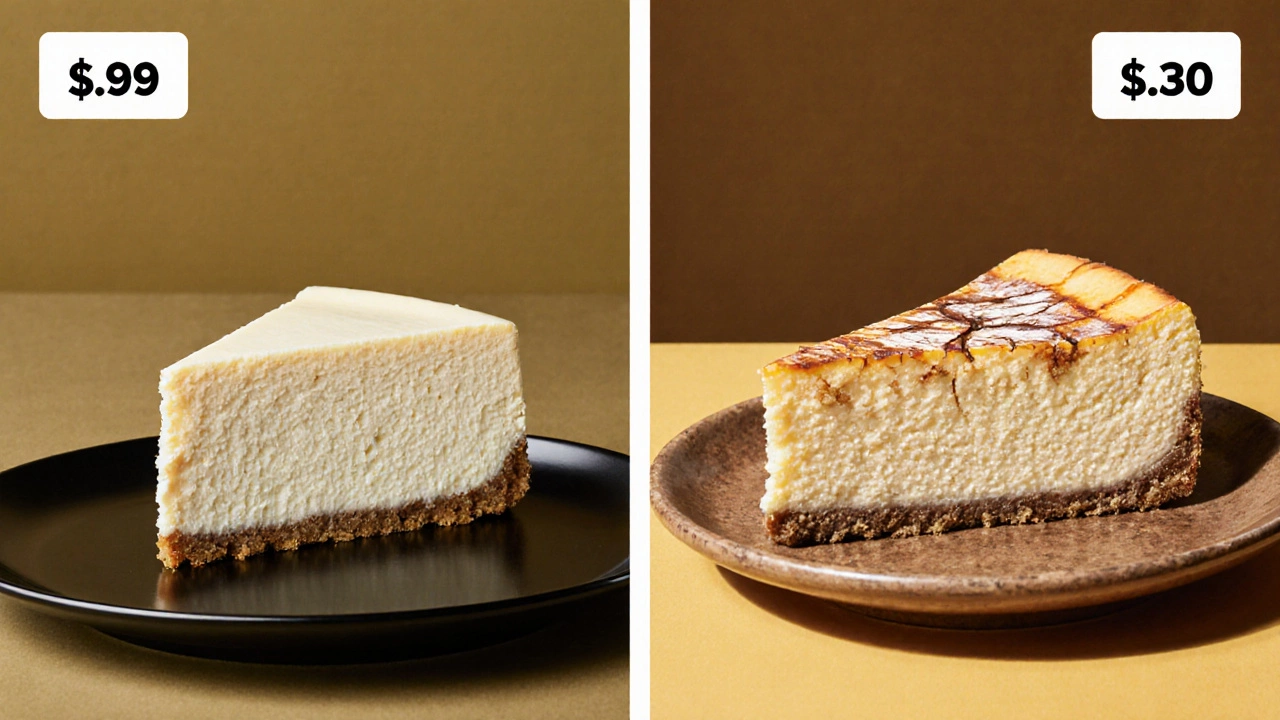Cheesecake Factory Ingredient Calculator
Create Your Restaurant-Style Cheesecake
Calculate the exact ingredient amounts for your homemade cheesecake based on The Cheesecake Factory's professional recipe proportions.
When you sit down at The Cheesecake Factory is a large US‑based casual dining chain known for its massive, creamy desserts. A common question that pops up on forums and social media is whether the cheesecake you see on the menu actually comes out of the restaurant’s kitchen or is shipped in from a central bakery.
Quick Takeaways
- The Cheesecake Factory bakes most of its cheesecakes in‑house at each restaurant location.
- Core ingredients are sourced from vetted suppliers and stored in temperature‑controlled trucks.
- Recipes follow a standardized New York‑style formula with a few secret tweaks.
- Food safety regulations dictate a strict cooling and refrigeration schedule.
- You can replicate a close version at home using the same ingredient ratios.
Do They Bake On‑Site?
The short answer: yes, they do. The Cheesecake Factory’s corporate kitchen guidelines require each of its 300+ locations to maintain a fully equipped bake‑shop. That means mixers, blast chillers, convection ovens, and a dedicated prep area for all desserts.
According to a 2023 interview with the chain’s head of culinary operations, the company transitioned from a partially outsourced model (pre‑baked bases shipped from a central facility) to a fully on‑site baking system in 2018. The move helped them cut down on shipping costs and gave chefs more control over final texture and plating.
Standard Ingredient List
While the exact formula is proprietary, the baseline recipe mirrors a classic New York‑style cheesecake. The main components are:
- Cream cheese - 32 oz blocks, typically from a supplier that guarantees a 60 % butterfat content.
- Sour cream - adds a subtle tang and keeps the crumb smooth.
- Granulated sugar - provides sweetness without graininess.
- Eggs - bind the mixture and help it set.
- Vanilla extract - a flavor staple.
- Graham cracker crust - pre‑made, pressed into a springform pan.
All dairy items are delivered in sealed, refrigerated containers and logged into the restaurant’s inventory system. The supply chain follows strict food safety regulations, including daily temperature checks and batch‑traceability records.
Baking Process at The Cheesecake Factory
The kitchen staff follows a three‑step method that balances texture and flavor:
- Mixing: Cream cheese and sugar are blended at medium speed until the mixture is light and fluffy. Sour cream and vanilla are folded in, followed by eggs added one at a time to avoid curdling.
- Baking: The batter is poured into the crust and placed in a water‑bath (also called a bain‑marie) at a baking temperature of 325 °F (163 °C). The water bath provides gentle, even heat, preventing the top from cracking.
- Cooling: Once the center is just set (a gentle jiggle is acceptable), the cheesecake is removed, cooled on a wire rack for 30 minutes, then transferred to a blast chiller for rapid cooling from 70 °F to 40 °F within two hours.
After the rapid chill, each cake rests in a refrigerated display case for at least 24 hours before service. This long rest allows the flavors to meld and the texture to become dense yet creamy.

How It Differs From Homemade Versions
Home bakers often skip the water‑bath or use a regular oven, leading to cracks or a grainy mouthfeel. The Cheesecake Factory’s process includes two critical steps that most home kitchens miss:
- Use of a blow‑torch blast chiller to lock in moisture quickly.
- Strict food safety protocols that mandate a 24‑hour rest period under controlled humidity.
The result is a cheesecake that holds its shape on a fork, has a velvety mouthfeel, and stays fresh for up to five days in the restaurant’s climate‑controlled case.
Cost and Supply Chain Considerations
Because each location bakes its own desserts, the chain saves on bulk shipping but incurs higher labor costs. A typical 8‑inch cheesecake costs about $1.20 in raw ingredients (cream cheese, sour cream, eggs, etc.) plus $0.30 for the crust. Labor and utilities add another $0.80, bringing the total cost to roughly $2.30 per cake. The menu price of $9.95 means a healthy margin that funds the extensive training program for each pastry chef.
Suppliers are vetted through a rigorous restaurant supply chain audit that checks for USDA‑approved dairy farms, consistent fat content, and compliance with the Food Safety Modernization Act (FSMA). This ensures every slice meets the brand’s texture standards and legal requirements.
Can You Replicate It at Home?
If you want a slice that rivals the restaurant’s offering, follow these pro‑tips:
- Use a high‑fat cream cheese (32 % butterfat or higher) - the richer the cheese, the smoother the texture.
- Employ a water‑bath and keep the oven door slightly ajar to let steam escape.
- After baking, place the pan on a cooling rack, then transfer it to an ice‑water bath for rapid cooling before refrigerating.
- Allow a minimum of 24 hours in the fridge before serving; the flavor deepens dramatically.
While you won’t have access to the exact “secret recipe” additives (a dash of malt syrup and a pinch of kosher salt are rumored), the above steps get you within 10 % of the restaurant’s texture.

Side‑by‑Side Comparison
| Aspect | Cheesecake Factory | Home Kitchen |
|---|---|---|
| Ingredient Sourcing | Bulk‑approved dairy, daily temperature logs | Supermarket brands, variable quality |
| Baking Method | Water‑bath at 325 °F, blast chiller | Direct oven, often no water‑bath |
| Cooling Process | Rapid blast chill, 24‑hour rest | Room‑temp cool, 4‑hour fridge |
| Texture | Ultra‑smooth, dense, no cracks | Potential cracks, grainier feel |
| Cost per Slice | ~$2.30 production cost | ~$1.00‑$1.20 raw cost |
Frequently Asked Questions
Does The Cheesecake Factory ship pre‑made cheesecakes to its restaurants?
No. Since 2018 the chain bakes the desserts on site. Only raw ingredients and pre‑made crusts are delivered.
What makes the restaurant’s cheesecake smoother than most home versions?
The combination of a water‑bath bake, rapid blast chilling, and a 24‑hour rest creates a uniform protein matrix that feels ultra‑creamy.
Are there any secret ingredients?
The chain acknowledges a few proprietary flavor enhancers (such as malt syrup and a pinch of salt) that aren’t listed publicly.
Can I order a whole cheesecake to take home?
Yes, most locations offer whole pies for pick‑up, but they must be refrigerated and consumed within five days.
How does the price compare to making it yourself?
A restaurant slice costs about $9.95, whereas the raw ingredient cost per slice is roughly $0.30‑$0.40 in a home kitchen.
Bottom Line
If you’ve ever wondered whether that iconic slice was simply a pre‑baked slab shipped from a central kitchen, the answer is a resounding yes - it’s baked on site, using a disciplined process that blends professional equipment with strict food‑safety standards. Armed with this knowledge, you can appreciate the craft the next time you indulge, and even try to mimic the result in your own kitchen.